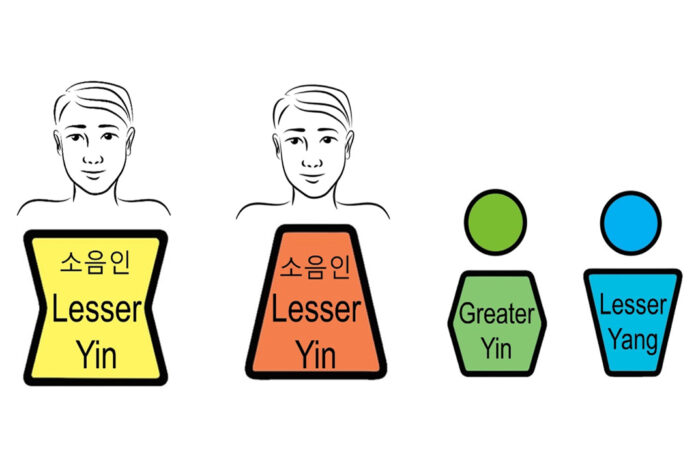
Body types are diagnosed and grouped by a person’s strongest and weakest organs
By David Lee, L.Ac.
Constitutional medicine is respected for its ability to heal, even difficult diseases. The biggest challenge has been establishing the correct diagnosis. Through the work of scholars of the world, we now have many ways to identify the Soeumin constitution. The word Soeumin means Lesser Yin in Korean. “So” is Lesser, “Eum” is Yin, and “In” is Person. Korean Four Constitutions Sasang Medicine is built on the foundation of Yin and Yang and Five Elements. Bigrams are the basic four body types, which includes the Lesser Yin.

According to Dr. Jema Lee, founder of Sasang medicine, a Lesser Yin has small Spleen and large Kidney. He identified two types of Lesser Yins. One was petite and the other with a larger frame, similar to that of a Greater Yin. Both the Lesser Yin types have Excessive Water and Deficient Earth. But one Lesser Yin type has Excessive Metal and Deficient Wood. The other is opposite with Deficient Metal and Excessive Wood.
|
|
SOEUMIN 1 (Lesser Yin & Greater Yang) |
SOEUMIN 2 (Lesser Yin & Greater Yin) |
|
Wood |
Deficient
|
Excessive |
|
Fire |
Deficient |
Deficient |
|
Earth |
Deficient |
Deficient |
|
Metal |
Excessive |
Deficient |
|
Water |
Excessive |
Excessive |
Dr. Jema Lee in Korea was not unique in identifying the constitutions. India, Europe, and United States had also identified them. Beginning with Hippocrates in 400 B.C. to the 20th century, many thinkers had identified the constitutions in their variant characteristics.
|
Jema Lee |
SOEUMIN 1 |
SOEUMIN 2 |
|
Hippocrates |
Phlegm |
Black Bile |
|
Unani Galen- Avicenna |
Phlegmatic |
Melancholic |
|
cold and wet |
cold and dry |
|
|
Ayurveda Dosha |
Vata |
Kapha |
|
Social Styles |
Amiable |
Analytical |
|
DiSC |
Steady |
Conscientious |
|
Myers-Briggs |
ENFJ, INFJ, ENTJ, INTJ |
ESFJ, ISFJ, ESTJ, ISTJ |
|
Need Theory |
Affiliation |
Affiliation |
They all have underlying commonalities as follows:
Soeumin 1 Types are physically thin, light frame and excellent in agility. The energy comes in bursts and they get fatigued easily, requiring frequent rests. They get chilled easily. Hands and feet can get cold easily. They sleep light and their digestion can be sensitive.
In an average situations, Soeumin 1 are accommodating, agreeable, congenial, cooperative relationships, dependable, diplomatic, does not interrupt, easy-going, friendly, good listener, joint cooperation, loyal team player, patient, people-oriented, pliable, polite, respectful, sensitive to others’ feelings, sentimental, slow-paced, supportive, trusting, understanding, warm, and willing.
In high tension situations, Soeumin 1 can be acquiescing, avoiding open disagreement, conforming, dependent, lacking initiative for action, not opinionated, overly reliant on relationships, overly subjective, passive, soft-hearted, submissive, too considerate of others, unassertive, and unsure.
Soeumin 2 types are physically strong build and have excellent stamina. Their movements are slow and deliberate. Large, soft eyes. Smooth and thick hair. Although muscular, much of the weight fluctuation is from fluid retention.
In average situations, Soeumin 2 are accurate, anticipating, calculating, careful, cautious, collected response, consistent, cool demeanor, critical, data-gathering, deliberate, detail-oriented, diligent, double-checking, exacting, fact-oriented, impersonal, industrious, keeping track, logical, mechanical, methodical, meticulous, objective, orderly, organized, patient, persistent, precise, punctual, quiet, reserved, serious, slow-paced, supportive, systematic, task-orientated, technical, thinking through, thorough, and willing to listen.
In high tension situations, Soeumin 2 are impersonal approach, indecisive, lack of enthusiasm, overly analytical, overly detailed, overly objective, picky, serious, stiff, stuffy, unresponsive, and unwilling to take risks.
There is no more confusion in making a correct constitutional diagnosis. Now with many diagnostic tools using psychological, physiological, and physical characteristics, the practitioner can correctly match the acupuncture, herbal, and diet treatments. Furthermore, the practitioner can identify the two Lesser Yin types to address the secondary constitutions of Greater Yang and Greater Yin.
































